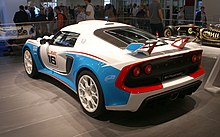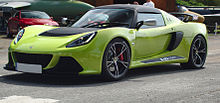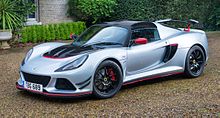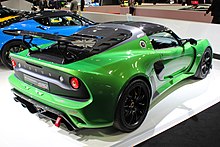Lotus Exige
| Lotus Exige | |
|---|---|
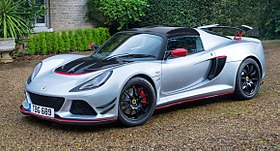 Lotus Exige Sport 380 (Series 3) | |
| Overview | |
| Manufacturer | Lotus Cars |
| Production | 2000–present |
| Assembly | Hethel, Norfolk, England |
| Body and chassis | |
| Class | Sports car (S) |
| Body style | |
| Layout | Rear mid-engine, rear-wheel drive |
| Platform | Lotus Elise |
| Related | |
| Powertrain | |
| Engine |
|
| Transmission | 6-speed manual |
| Dimensions | |
| Length | 149.5 in (3,797 mm) |
| Width | 68.0 in (1,727 mm) |
| Height | 45.6 in (1,158 mm) |
| Kerb weight |
|
The Lotus Exige /ɛɡˈziːʒ/ is a British two-door, two-seat sports car made by Lotus Cars since 2000. Originally a more-hardcore coupé version of the Lotus Elise roadster, since the Series 3 the Exige has been the larger-engined model of the family - using a V6 engine in place of the Elise's straight 4 with convertible versions of both available.
Series 1[edit]
The original Exige was launched in 2000 with a naturally aspirated 1.8 L Rover K Series Inline-four engine in VHPD (Very High Performance Derivative) tune. It produces 177 bhp (132 kW; 179 PS) at 7,800 rpm in standard form.[1] There was also a "track spec" version with 190 bhp (142 kW; 193 PS) available. The car has a five-speed manual gearbox, and a claimed top speed of 219 km/h (136 mph). 0–60 mph (97 km/h) was achieved in 4.7 seconds and 0–100 km/h (62 mph) in 4.9 seconds.[1]
The first Exige used the round, less aggressive headlights of the first generation Elise, although the Elise was updated soon after the introduction of the Exige. The Series 1 was built until 2002, in 604 examples, and was not replaced until the Series 2 of 2004.[2]
Series 2[edit]
Exige (2004–2006)[edit]
In 2004, the Series 2 Exige was introduced. It features a naturally aspirated 1.8 L 16-valve DOHC Toyota/Yamaha engine that produces 190 bhp (142 kW; 193 PS) with the Toyota engine designation of 2ZZ-GE.[3] Compared to the Series 2 Elise, it has a front splitter, fibreglass hardtop roof with roof scoop, rear engine cover, and rear spoiler. The sole purpose of these aerodynamic additions to the base Elise is to create more downforce (almost 100 pounds (45 kg) of downforce at 100 mph (161 km/h) in the Exige versus 13 lb (5.9 kg) at 100 mph (161 km/h) in the Elise).[3]
In February 2005, Lotus announced a limited production run of 50 Exiges, using the Toyota engine with a supercharger. This increased the power output to 243 bhp (181 kW; 246 PS). These vehicles were only available in yellow or black, representing the colours of Lotus Sport, and are badged 240R. They have a projected 0-60 mph (0–97 km/h) time of 3.9 seconds and 0-100 mph (0–161 km/h) of 9.9 seconds, with a top speed of 155 mph (249 km/h) at a cost of £44,000.
The North American Exige was unveiled at the Los Angeles Auto Show in January 2006.
According to Lotus, the standard Exige Series 2 model weighs 2,016 lb (914 kg) and has the following specifications:[citation needed]
- Engine
- Toyota Supplied, 1,796 cc (1.8 L; 109.6 cu in) I4, DOHC with VVTL-i (variable valve timing with lift intelligence) - Designed by Yamaha - Engine Code: 2ZZ-GE
- Bore/Stroke 82 mm × 85 mm (3.23 in × 3.35 in)
- 190 hp (142 kW; 193 PS) at 7,800 rpm
- 138 lb⋅ft (187 N⋅m) at 6,800 rpm
- Compression ratio: 11.5:1
- Transmission
6-Speed manual built by Aisin AI, close-ratio with single-plate dry clutch
- Performance
- 0–60 mph (0–97 km/h): 4.7 seconds
- 0–100 mph (0–161 km/h): 12.9 seconds
- Top speed: 147 mph (237 km/h)
- Fuel consumption: 24 mpg‑imp (12 L/100 km; 20 mpg‑US) city / 29 mpg‑imp (9.7 L/100 km; 24 mpg‑US) highway
Exige S[edit]
| Exige S | |
|---|---|
 | |
| Overview | |
| Manufacturer | Lotus |
| Production | 2006–2011 |
| Assembly | Hethel, Norfolk, England |
| Body and chassis | |
| Class | Sports car |
| Body style | 2-door coupé |
| Layout | MR layout |
| Related | Lotus Elise, Lotus Exige Lotus 2-Eleven |
| Powertrain | |
| Engine | 1.8 L (1,796 cc) Toyota 2ZZ-GE supercharged I4 |
| Transmission | 6-speed manual |
| Dimensions | |
| Wheelbase | 90.6 in (2,301 mm) |
| Length | 2006–07: 149.5 in (3,797 mm) 2008–2011: 149.0 in (3,785 mm) |
| Width | 2006–07: 68.0 in (1,727 mm) 2008–2011: 67.7 in (1,720 mm) |
| Height | 2006–07: 45.8 in (1,163 mm) 2008–2011: 45.0 in (1,143 mm) |
| Kerb weight | 2,057 lb (933 kg) |
In February 2006, Lotus announced the Exige S model which used a supercharged Toyota 2ZZ-GE engine producing 220 bhp (164 kW; 223 PS).[4] The S was also made available in North American markets as a 2007 model.
According to Lotus, the Exige S model, weighing 2,057 lb (933 kg), has the following specifications:
- Engine
- Toyota supplied, 1,796 cc (1.8 L) I4, DOHC with VVTL-i (variable valve timing and lift - intelligent), supercharged and intercooled
- Bore/Stroke 82 mm × 85 mm (3.23 in × 3.35 in)
- 218 hp (163 kW; 221 PS) at 7,800 rpm
- 159 lbf⋅ft (215 N⋅m) at 5,500 rpm
- Compression ratio: 11.5:1
- Transmission
6-speed, close ratio with single-plate dry clutch
- Performance
- 0-60 mph (97 km/h): 4.1 seconds
- 0-100 mph (161 km/h): 9.98 seconds
- Top speed: 148 mph (238 km/h)
- Fuel consumption: 24 mpg‑imp (12 L/100 km; 20 mpg‑US) city / 29 mpg‑imp (9.7 L/100 km; 24 mpg‑US) highway
Exige S 240 (2008-2011)[edit]
In 2008, the Exige S was replaced by the Exige S 240. Power output increased by 9% over the outgoing model to 240 bhp (179 kW; 243 PS). The S 240 also received upgraded AP Racing brakes from the Exige Cup 240 and a larger roof scoop utilised by the Exige Cup 255. 0-60 mph (0–97 km/h) times improved to 4.0 seconds.[5] The S 240 base manufacturer suggested retail price was $65,690.
Exige S 260 (2009–2011)[edit]
The Exige S 260 produced an additional 7% power output over the S 240 resulting in 260 PS (256 hp; 191 kW). Even with a full fuel tank, extensive use of weight-saving materials such as carbon fiber reduced the vehicle's gross weight to 2,020 lb (916 kg) compared to 2,077 lb (942 kg) in the S 240. It can accelerate from 0–60 mph (0–97 km/h) in 4.0 seconds.[6] After 2009, both the S 240 and S 260 received distinctively new and enlarged rear spoilers mounted to the rear clam instead of the motor bay cover. The base manufacturer suggested retail price for the S 260 was $74,995.
Exige 265E[edit]
| Exige 265E | |
|---|---|
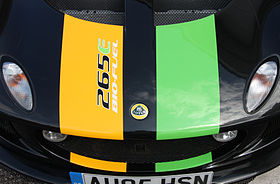 | |
| Overview | |
| Manufacturer | Lotus |
| Production | 1 Produced |
| Assembly | Hethel, Norfolk, England |
| Body and chassis | |
| Class | Sports Car |
| Body style | 2-door coupe |
| Layout | MR layout |
| Related | Lotus Elise, Lotus Exige |
| Powertrain | |
| Engine | 1.8L Toyota supercharged I4 |
| Transmission | 6-speed manual |
| Dimensions | |
| Length | 149.5 in (3,797 mm) |
| Width | 68.0 in (1,727 mm) |
| Height | 45.8 in (1,163 mm) |
| Kerb weight | 2,050 lb (930 kg) |
The Exige 265E is a factory-built version of an Exige S optimised to run on E85 fuel, which is 85% ethanol. The higher octane of this biofuel allows for a higher compression ratio and/or more supercharger boost. In this model, which saw the ECU re-mapped as well as upgraded injectors and fuel pump to cope with the new fuel type, the brakes have also been upgraded to four-piston AP Racing calipers with increased diameter 310 mm (12.2 in) sport brake pads mated with drilled and vented discs at the front. Brembo single-piston sliding rear calipers with 282 mm (11.1 in) diameter discs are fitted at the rear. Lotus says it has no intention to build the 265E (265 indicates the approximate horsepower and the E indicates the "environmentally favourable bio-ethanol E85 fuel" powering the engine) as a limited number standard production car, and that it is simply a biofuels demonstrator.[7] According to Lotus, the Exige 265E model has the following specifications:
- Engine
- Toyota supplied 2ZZ-GE 1,796 cc inline-4, DOHC with VVTL-i (variable valve timing with lift intelligence), supercharged and intercooled
- Bore/Stroke 82 mm/85 mm
- 264 hp (197 kW) at 8,000 rpm
- 184 lb⋅ft (249 N⋅m) at 5,500 rpm
- Compression ratio: 11.5:1
- Transmission
- C64 6-Speed, close ratio with single-plate dry clutch
- Exige 265E performance
- 0-60 (0-97 km/h): 3.88 seconds
- 0-100 mph (0-161 km/h): 9.2 seconds
- Top speed: 158 mph (254 km/h)
- Fuel consumption: ~25 miles per imperial gallon (11 L/100 km; 21 mpg‑US) city / 65 miles per imperial gallon (4.3 L/100 km; 54 mpg‑US) highway
Exige GT3 prototype (2007)[edit]
| Exige GT3 | |
|---|---|
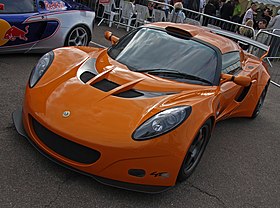 | |
| Overview | |
| Manufacturer | Lotus |
| Production | 1 (prototype) |
| Assembly | Hethel, Norfolk, England |
| Body and chassis | |
| Class | Sports Car |
| Body style | 2-door coupe |
| Layout | MR layout |
| Related | Lotus Elise, Lotus Exige |
| Powertrain | |
| Engine | 1.8L Toyota supercharged I4 |
| Transmission | 6-speed manual |
| Dimensions | |
| Length | 153.8 in (3,907 mm)[8] |
| Width | 71.9 in (1,826 mm)[8] |
| Height | 44.4 in (1,128 mm)[8] |
| Kerb weight | 2,050 lb (930 kg) |
According to Lotus, the Exige GT3 model has the following specifications:[9]
- Engine
- Toyota supplied 2ZZ-GE, 1,796 cc (1.8 L; 109.6 cu in) inline 4, DOHC with VVTL-i and Lotus T4e engine management system, Eaton M62 Roots type supercharger and intercooled
- Bore/Stroke 82 mm × 85 mm (3.23 in × 3.35 in)
- 275 PS (202 kW; 271 hp) at 8,000 rpm
- 250 N⋅m (184 lb⋅ft) at 7,000 rpm
- Compression ratio: 11.5:1
- Transmission
- C64 6-speed, close ratio with uprated clutch and cover, open differential
- Gear ratios I/II/III : 3.166:1 / 2.050:1 / 1.481:1
- IV/V/VI : 1.166:1 / 0.916:1 / 0.815:1
- R/final drive : 3.250:1 / 4.529:1
- Exige GT3 performance
- 0-60 mph (97 km/h) : 3.9 seconds
- 0-100 km/h (62 mph) : 4.0 seconds
- 0-100 mph (161 km/h) : 9.8 seconds
- Top Speed : 160 mph (257 km/h) - electronically limited
- Power-to-weight ratio : 362.3 bhp (270 kW; 367 PS) per tonne
Note: While the mass of the vehicle was not disclosed, it is estimated to be around 1,650 lb (748 kg) from the disclosure of the power-to-weight ratio.
Exige GT3 of Angelo Lazaris (2008–2011)[edit]
It is a version of Exige GT3 for the 2008 GT Championship, based on the European race car that competed in the FIA GT3 category. It included the 1.8-litre engine based on the Exige S road car rated at 355 PS (261 kW; 350 hp) at 7,000 rpm and 305 N⋅m (225 lb⋅ft) at 6,000 rpm, increased frontal area to accommodate the wider track, revising the front radiator inlet and outlet areas, reducing the cross-sectional areas of both, extending the nose forward by approximately 3 cm (1 inch), bodywork extending 8 cm rearward, widening 10 cm (3.9 inches) and losing almost 3 cm in height at the rear deck, body parts produced in lightweight ZPREG carbon fibre using an innovative mould-making process that features room temperature curing rather than an oven, elimination of roof scoop that fed cooling air to the engine's intercooler, change to a water-to-air intercooler.
The vehicle was unveiled in round three of the 2008 GT Championship.[10]
Union Jack Lotus Exige S (2008)[edit]
It is a version of Lotus Exige S with a flying British flag body, developed by Lotus Design.
The car was featured in Discovery Channel's How Do They Do It? series.[11][12]
Exige Scura/Stealth (2009)[edit]

It is a limited production run version of only 35 units of the Lotus Exige S with 1,796 cc (1.8 L; 109.6 cu in) supercharged and intercooled Inline-4 engine from Exige Cup 260 rated at 260 PS (191 kW; 256 bhp) at 8,000 rpm and 236 N⋅m (174 lb⋅ft) at 6,000 rpm of torque,[13] matte black body colour, Phantom Black triple stripes that run the length of the car, carbon-fibre front splitter, oil cooler inlet vanes, side airscoops and rear spoiler, seats and centre console made from carbon fibre, anodised handbrake and gear knob in anthracite colour, carbon-fibre components in high-gloss clear lacquer finish, Lotus Launch Control, Lotus Traction Control, variable-slip traction control, Öhlins 2-way adjustable dampers, Eibach Springs with variable-height spring platforms, matt black lightweight forged wheels with Yokohama 048 LTS tyres, ride height adjustment to reduce the ride height from 130 mm (5.12 in) to 120 mm (4.72 in), lightweight flywheel, sports-type clutch plate, heavy-duty clutch cover, C64 six-speed gearbox (with an aluminium casing) and Accusump (engine oil accumulator unit).
Orders for the 'Lotus Exige Scura' began from 21 October 2009 in Europe, South Korea, Australia, South Africa, Thailand, Taiwan, Hong Kong, Singapore, New Zealand, Indonesia and Malaysia. The vehicle was sold in Japan as 'Lotus Exige Stealth'.
Lotus Exige Stealth was unveiled at the 2009 Tokyo International Motorshow.[14][15]
Lotus Exige S RGB Special Edition (2010)[edit]
This is a version of the Lotus Exige S commemorating Roger Becker, the former Director of Vehicle Engineering for Lotus.[16] It includes Toyota's supercharged 1.8 litre 2ZZ VVTL-i engine rated at 260 PS (191 kW; 256 hp), Lotus ultra lightweight forged alloy wheels, Performance pack, Sport pack, Touring pack, choice of four body colours (Aspen White, Starlight Black, Solar Yellow & Carbon Grey), Roger Becker's signature on the rear of the car, a Roger Becker numbered plaque, monochrome Lotus badges, structural shear panel (which increases the lateral stiffness of the rear subframe by 30%) and air conditioning.
The vehicle went on sale in September 2010, and ended at the end of 2010 in Europe due to changes in legislation and the introduction of "Euro 5" Type Approval which does not apply to vehicles with 1.8-litre 2ZZ VVTL-i engines.[17]
The vehicle was unveiled at the 2010 LA Auto Show.[18]
Exige Matte Black Final Edition (2011)[edit]
It is a limited (25 units) version of the Lotus Exige for the North America market, commemorating the end of the Exige's production. It includes an engine rated at 261 PS (192 kW; 257 hp), matte black body colour, black Alacantara sport seats and a uniquely numbered plate for each car.
The vehicle was unveiled in Pebble Beach Week 2011.[19]
Production[edit]
Production of North American version of Exige ended in August 2011 after the expiration of "smart" airbags exemption, and Toyota stopping production of its 2ZZ-GE four-cylinder engine.[20]
Exige S 260 Final Edition (2011)[edit]
To mark the end of an era of Lotus Exige production, Lotus created the Exige S 260 Final Edition, exclusively for North America. With power upgraded to 257 bhp, and a high level of standard equipment, the Exige S 260 Final Edition was available in multiple colour choices from the full Lotus colour range. Only 30 examples of this Exige were built, all for the North American market.
Specifications[edit]
- 1.8 litre Toyota Supercharged 2ZZ VVTL-I engine producing 257 bhp.
- Full Lotus exterior colour range was available (standard & metallic paints at no extra cost, lifestyle & limited paints at an extra cost).
- Three-element rear wing, splitter, side scoops and roof scoop.
- Body coloured rear wing, splitter, side scoops and roof scoop.
- Double shear track control arm brace.
- Y type 5-spoke forged alloy wheels in black finish (6" Front, 7.5" Rear).
- Limited Slip Differential (LSD)
Upgrade options included[edit]
- Sport Pack: ProBax sport seats, Lotus Traction Control System (TCS), BS4 T45 steel roll-over hoop and struts and Adjustable front anti-roll bar.
- Touring Pack: padded leather door panels, perforated leather door inserts, leather trimmed center console, black perforated leather handbrake-lever gaiter, black carpet mats with embroidered Exige logo, noise insulation material, iPod stereo connection and trinket tray divider and cup holder.
- Track Pack: Track suspension (Ohlins dampers and adjustable ride height)
Series 3[edit]
Exige S V6 (2012–2015), Exige S V6 Roadster (2013–2016)[edit]
At the Frankfurt 2011 autoshow, the 2012 version of the Exige S was announced. It includes a supercharged 3.5 litre V6 engine (from the Evora S) rated at 345 hp (257 kW; 350 PS). In 2013 a roadster version was introduced with only minor changes to the design for the removable top. The engine and performance were virtually unchanged from the coupe and the price for both the roadster and the coupe were the same.[21][22][23][24][25]
Specifications[edit]
- Powerplant: 3,456 cc (3.5 L; 210.9 cu in) Toyota 2GR-FE Supercharged V6 engine
- Max. power: 345 bhp (350 PS; 257 kW) at 7,000 rpm
- Max. torque: 400 N⋅m (295 lb⋅ft) at 4,500 rpm.
- Gearbox: 6-speed Toyota EA60 manual transmission; automatic transmission available as an option.
- Weight: 1,176 kg (2,593 lb).
- Acceleration: 0–60 mph (97 km/h) in 3.8 seconds; 3.9 seconds for automatic version.[26]
- Top speed: 172 mph (277 km/h)[27]
- Tyres: Pirelli P Zero Corsa tyres included as standard with optional £800 Pirelli Trofeo R tyres.
- Price: starts at £52,900.[26]
To accommodate the V6 engine, the new model is approximately 25 cm (9.8 inches) longer and 5 cm (2.0 in) wider (exterior bodywise) than the model with the inline-four engine,[22] being 4,052 mm (159.5 inches) long, 1,802 mm (70.9 in) wide (not counting the mirrors) and 1,153 mm (45.4 in) tall. The drag coefficient is 0.433.
Exige V6 Cup, Exige V6 CupR (2013–2016)[edit]
The Exige V6 Cup is a track oriented version of the Exige S while the Exige CupR is the track-only version of Exige V6 Cup. The Exige V6 Cup is offered for sale in the United States as a track only car. If purchased, US Lotus Dealers will only provide a bill of sale instead of a title.[28] The vehicles were unveiled at the 2013 Autosport International motor show.[19]
Specifications[edit]
Exige V6 Cup According to Lotus, the Exige Cup has the following specifications:[29]
- Engine: 3.5 litre Toyota DOHC V6 VVT-i, 24-valve, equipped with Harrop HTV 1320 supercharger producing 345 hp (350 PS) and 400 N⋅m (295 lb⋅ft) of torque at 7,000 rpm.
- Transmission: 6-speed Toyota EA60 close ratio manual transmission, Sequential gearbox with paddleshift (optional).
- Layout: Mid mounted, transverse, rear wheel drive.
- Weight: 1,110 kg (2,447 lb).
- Acceleration: 0-60 mph (97 km/h) in 3.8 seconds.
- Top speed: 170 mph (274 km/h).
- Suspension: Double wishbone suspension with anti-roll bars (front and rear).
- Brakes: AP Racing four-piston calipers (front and rear) with ventilated and cross drilled 2 piece discs.
- Tyres: Pirelli P Zero Corsa tyres included as standard
Exige V6 Cup R The Lotus Exige V6 Cup R has the following specifications according to Lotus:[30]
- Engine: 3.5 litre Toyota DOHC V6 VVT-i, 24-valve, equipped with Harrop HTV 1320 supercharger producing 366 PS (361 hp; 269 kW) and 413 N⋅m (305 lb⋅ft) of torque at 7,200 rpm.
- Transmission: 6-speed Toyota EA60 close ratio manual transmission, Sequential gearbox with paddleshift (optional).
- Layout: Mid mounted, transverse, rear wheel drive.
- Weight: 1,040 kg (2,293 lb) (dry weight).
- Acceleration: 0-60 mph (97 km/h) in 3.8 seconds.
- Top speed: 170 mph (274 km/h).
- Suspension: Double wishbone suspension with anti-roll bars (front and rear).
- Brakes: AP Racing four-piston calipers (front and rear) with ventilated and cross drilled 2 piece discs.
- Tyres: Pirelli P Zero Corsa tyres included as standard
Lotus Exige 360 Cup (2015–Present)[edit]
Limited to 50 examples, Lotus Exige 360 Cup was revealed on 14 August 2015. The car is powered by a 3.5-liter supercharged Toyota V6 delivering 355 hp (360 PS; 265 kW) .[31]
Specifications[edit]
The Exige 360 Cup has the following specifications as stated by Lotus[32]
- Engine: 3.5 litre Toyota DOHC V6 VVT-i, 24-valve, equipped with Harrop HTV 1320 supercharger producing 350 PS (345 hp; 257 kW) and 400 N⋅m (295 lb⋅ft) of torque at 7,000 rpm.
- Transmission: 6-speed Toyota EA60 close ratio manual transmission, Sequential gearbox with paddleshift (optional).
- Layout: Mid mounted, transverse, rear wheel drive.
- Weight: 1,250 kg (2,756 lb) (dry weight).
- Acceleration: 0-60 mph (97 km/h) in 3.8 seconds.
- Top speed: 170 mph (274 km/h).
- Suspension: Double wishbone suspension with anti-roll bars (front and rear).
- Brakes: AP Racing four-piston calipers (front and rear) with ventilated and cross drilled 2 piece discs.
- Power to weight ratio: 307 hp/tonne (311 PS/1000 kg).
Lotus Exige Sport 380 (2016–Present)[edit]
The Lotus Exige Sport 380 is a track focused and more powerful version of the Lotus Exige lineup. It was unveiled on 23 November 2016. Lotus' CEO, Jean-Marc Gales describes it as, "The Exige Sport 380 is so good, that it is no longer the best in class, it’s now in a class of its own", and it fulfills this statement by taking on some of the powerful and expensive super cars both on the track and the streets. The 3.5-litre, super-charged V6 engine is now uprated and produces 375 hp (380 PS; 280 kW) and 410 N⋅m (302 lb⋅ft) of torque with a 6500 rpm red line achieved by revised supercharger and ECU. It can accelerate from 0 to 60 mph (97 km/h) in 3.5 seconds and has a top speed of 178 mph (286 km/h). The interior is also stripped out and features necessary driver aids. The Exige Sport 380 weighs 1,076 kg (2,372 lb), thanks to the extensive use of carbon fiber on the exterior as well as the interior, the application of polycarbonate windows instead of traditional glass windows and a newly designed rear transom panel which features two rear lights instead of four.[33]
Lotus Exige Cup 380 (2016–Present)[edit]
The Lotus Exige Cup 380 is a more hardcore variant of the Exige Sport 380. Performance of the car remains the same as the Sport 380 but it features more aero components and a larger rear wing to produce more downforce at high speeds. The Exige Cup 380 generates 200 kg (441 lb) of downforce at its maximum speed of 175 mph (282 km/h); the top speed is reduced due to excess downforce and more drag. It features a more stripped out interior in order to save weight and other light weight carbon fiber components, Lotus states a lowest possible dry weight of only 1,057 kg (2,330 lb).[34]
Lotus Exige Cup 430 (2017–Present)[edit]
On 9 November 2017, Lotus unveiled the most powerful version of the Exige to date called the Exige Cup 430, producing 430 PS (424 hp; 316 kW) and using the Evora GT430's powertrain, modified to fit in the smaller Exige. The car body can produce 220 kg (485 lb) of downforce. The Cup 430 is 19 kg (42 lb) lighter than the Sport 380 due to the use of carbon fibre in body panels and interior and a titanium exhaust. The gearbox allows quicker gearshifts than the previous model. The Cup 430 is not offered with an automatic gearbox. The Lotus Exige Cup 430 is capable of covering the Hethel circuit in 1 minute 24.8 seconds – the fastest production car to lap the circuit – 1.2 seconds faster than the road going Lotus 3-Eleven.
Specifications[edit]
The Exige Cup 430 has the following specifications according to Lotus:[35]
- Engine: 3.5 litre Toyota DOHC V6 VVT-i, 24-valve, equipped with an Edelbrock supercharger and a charge cooler producing 430 hp (436 PS; 321 kW) at 7,000 rpm and 440 N⋅m (325 lb⋅ft) of torque at 4,000 rpm.
- Transmission: 6-speed Toyota EA60 close ratio manual transmission with gearbox cooler coupled to Lotus developed aluminium precision shift mechanism.
- Layout: Mid mounted, transverse, rear wheel drive.
- Weight: 1,056 kg (2,328 lb) (lowest possible dry weight, after the removal of optional airbags).
- Acceleration: 0-60 mph (97 km/h) in 3.2 seconds.
- Top speed: 180 mph (290 km/h).
- Suspension: Double wishbone suspension with anti-roll bars (front and rear).
- Brakes: AP Racing four-piston calipers (front and rear) with ventilated and cross drilled 2 piece discs.
- Tires: Michelin Pilot Sport Cup 2 tyres (front 215/45 R17, rear 285/30 R18).
- Power to weight ratio: 407 hp/tonne (413 PS/1000 kg).
Racing[edit]
Several Exiges are currently in use in the SCCA Pro Racing World Challenge.[36] An Exige GT3 and some CUP Exige race in the Supercar Challenge.[37] An Exige has participated in the GT300 class of the 2005 Super GT Series season.
Simply Sports Cars in Australia ran an Exige Cup R in endurance racing during 2014 and 2015 at the world renowned Bathurst 12 Hour, with class wins on both occasions.
See also[edit]
- Hennessey Venom GT, an American supercar built on a modified Lotus Exige chassis
- List of rally cars
References[edit]
- ^ Jump up to: a b Nötzli, Max, ed. (7 March 2002). Automobil Revue 2002 (in German and French). 97. Berne, Switzerland: Büchler Grafino AG. p. 369. ISBN 3-905-386-02-X.
- ^ Ringma, Ronald. "Genealogy: Lotus Exige". Lotus Drivers Guide.
- ^ Jump up to: a b Walton, Chris (28 June 2006). "Full Test: 2006 Lotus Exige". Edmunds Inc. Archived from the original on 25 June 2008. Retrieved 7 March 2008.
- ^ Brown, Greg N. (February 2007). "Newcomers: 2007 Lotus Exige S". MotorTrend. Source Interlink Media, Inc. Retrieved 7 March 2008.
- ^ "2008 Lotus Exige S 240". Car and Driver.
- ^ Vaughn, Mark (23 April 2009). "Lotus Exige S 260 Sport: Track-happy two-seater gets greater". AutoWeek Magazine. Retrieved 11 May 2009.
- ^ Lotus Engineering, "Exige 265E Bio-Fuel: British, Racing and Very Green," "Archived copy". Archived from the original on 24 July 2008. Retrieved 23 September 2008.CS1 maint: archived copy as title (link)
- ^ Jump up to: a b c Lavrinc, Damon (13 March 2008). "Lotus debuting 350 hp Exige GT3 Down Under". Autoblog/Weblogs, Inc. Retrieved 24 October 2009.
- ^ Spinelli, Mike (6 March 2007). "Geneva Showcase: Lotus Exige GT3". Jalopnik. Retrieved 24 October 2009.
- ^ Damon Lavrinc. "Lotus debuting 350 hp Exige GT3 Down Under". Autoblog.
- ^ Alex Nunez. "That's a wrap! Union Jack Lotus Exige S filmed for Discovery Channel". Autoblog.
- ^ Capra Ovidiu (28 March 2008). "Union Jack Lotus Exige S". ZerCustoms.
- ^ "2009 Lotus Exige Scura". automobile-catalog.com. Retrieved 28 June 2018.
- ^ Frank Filipponio. "Tokyo Preview: Lotus Exige Scura and Stealth cross over to dark side". Autoblog.
- ^ Sam Abuelsamid. "Tokyo 2009: Lotus Exige Stealth, complete with soft-touch paint". Autoblog.
- ^ Simona (21 June 2010). "2010 Lotus Elise SC And Exige S RGB Special Editions". Top Speed.
- ^ Sam Abuelsamid. "Lotus to produce Roger Becker edition Elise and Exige". Autoblog.
- ^ Damon Lavrinc. "LA 2010: 2011 Lotus Exige SC RGB Edition". Autoblog.
- ^ Jump up to: a b Zach Bowman. "Lotus announces race-ready Exige V6 Cup and Cup R". Autoblog.
- ^ Damon Lavrinc. "Lotus ending production of NA-spec Elise/Exige in August". Autoblog.
- ^ "Top Gear drives the Lotus Exige V6". topgear.com. January 2012. Retrieved 5 April 2012.
- ^ Jump up to: a b "2012 Lotus Exige S". Topspeed.com. 6 January 2012. Retrieved 5 April 2012.
- ^ "Lotus Exige V6". evo.co.uk. 12 September 2011. Retrieved 5 April 2012.
- ^ "2011 Frankfurt Auto Show: Lotus Exige S Reborn With Supercharged V6". autoguide.com. 13 September 2011. Retrieved 5 April 2012.
- ^ "Autocar Lotus Exige S Roadster first drive". autocar.co.uk. June 2013. Retrieved 30 October 2017.
- ^ Jump up to: a b "Lotus Exige S review price and specs". evo.co.uk. 26 June 2014. Retrieved 28 September 2017.
- ^ "2012-2015 Lotus Exige S". Topspeed.com.
- ^ "Lotus Confirms Exige V6 Cup Track Car For U.S." Motor Authority. 20 August 2012. Retrieved 20 May 2015.
- ^ "specifications of the Exige V6 Cup". Lotus Cars. Retrieved 28 September 2017.
- ^ "specifications of the Exige V6 Cup R" (PDF). Lotus Cars. Retrieved 28 September 2017.
- ^ "Lotus Exige 360 Cup: Another Small-Batch Lotus". Car and Driver. 14 August 2015. Retrieved 16 August 2015.
- ^ "specifications of the Exige V6 Cup". Lotus Cars. Retrieved 28 September 2017.
- ^ Lotus Cars. 23 September 2017 http://www.lotuscars.com/exige-sport-380. Retrieved 24 September 2017. Missing or empty
|title=(help) - ^ Lotus Cars http://www.lotuscars.com/exige-cup-380. Retrieved 27 September 2017. Missing or empty
|title=(help) - ^ Lotus Cars. 9 November 2017 http://www.lotuscars.com/exige-cup-430. Retrieved 9 November 2017. Missing or empty
|title=(help) - ^ "SCCA Pro Racing World Challenge". World-challenge.com. Retrieved 26 June 2010.
- ^ "Supercar Challenge". Supercarchallenge.nl. Retrieved 6 October 2012.
External links[edit]
| Wikimedia Commons has media related to Lotus Exige. |
- Exige 265E review
- Article on Exige 265E by GreenerMachine.com
- 2008 Lotus Exige S 240 Review and specs; Sport Compact Car Magazine
- Lotus Exige Owners Club
| hide | |||||||||||||||||||||||||||||||||||||||||||||||||||||||||||||||||||||||||
|---|---|---|---|---|---|---|---|---|---|---|---|---|---|---|---|---|---|---|---|---|---|---|---|---|---|---|---|---|---|---|---|---|---|---|---|---|---|---|---|---|---|---|---|---|---|---|---|---|---|---|---|---|---|---|---|---|---|---|---|---|---|---|---|---|---|---|---|---|---|---|---|---|---|
| Type | 1950s | 1960s | 1970s | 1980s | 1990s | 2000s | 2010s | 2020s | |||||||||||||||||||||||||||||||||||||||||||||||||||||||||||||||||
| 0 | 1 | 2 | 3 | 4 | 5 | 6 | 7 | 8 | 9 | 0 | 1 | 2 | 3 | 4 | 5 | 6 | 7 | 8 | 9 | 0 | 1 | 2 | 3 | 4 | 5 | 6 | 7 | 8 | 9 | 0 | 1 | 2 | 3 | 4 | 5 | 6 | 7 | 8 | 9 | 0 | 1 | 2 | 3 | 4 | 5 | 6 | 7 | 8 | 9 | 0 | 1 | 2 | 3 | 4 | 5 | 6 | 7 | 8 | 9 | 0 | 1 | 2 | 3 | 4 | 5 | 6 | 7 | 8 | 9 | 0 | |||
| Sports racer | Mark VIII | Mark IX | Eleven | 15 | 17 | 19 | 23 | 30 | 40 | 47 | 62 | ||||||||||||||||||||||||||||||||||||||||||||||||||||||||||||||
| Mark VI | Seven | 340R | 2-Eleven | 3-Eleven | |||||||||||||||||||||||||||||||||||||||||||||||||||||||||||||||||||||
| Sports car | Evija | ||||||||||||||||||||||||||||||||||||||||||||||||||||||||||||||||||||||||
| Roadster | Elan | Elan M100 | Elise | Elise | |||||||||||||||||||||||||||||||||||||||||||||||||||||||||||||||||||||
| Coupé | Elite | Elan | Exige | Exige | Exige | ||||||||||||||||||||||||||||||||||||||||||||||||||||||||||||||||||||
| Eclat | Excel | Evora | |||||||||||||||||||||||||||||||||||||||||||||||||||||||||||||||||||||||
| Grand tourer | Elan +2 | Elite | |||||||||||||||||||||||||||||||||||||||||||||||||||||||||||||||||||||||
| Europa | Esprit | Europa S | |||||||||||||||||||||||||||||||||||||||||||||||||||||||||||||||||||||||
| Saloon | Ford Cortina Lotus | Ford Cortina Lotus | Carlton/Omega | ||||||||||||||||||||||||||||||||||||||||||||||||||||||||||||||||||||||
| Racing cars | |||||||||||||||||||||||||||||||||||||||||||||||||||||||||||||||||||||||||
| Related cars | |||||||||||||||||||||||||||||||||||||||||||||||||||||||||||||||||||||||||
| Concept cars | |||||||||||||||||||||||||||||||||||||||||||||||||||||||||||||||||||||||||
| Key figures | |||||||||||||||||||||||||||||||||||||||||||||||||||||||||||||||||||||||||
| Group Lotus | |||||||||||||||||||||||||||||||||||||||||||||||||||||||||||||||||||||||||
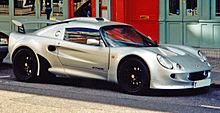
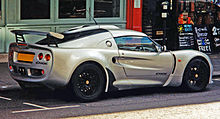
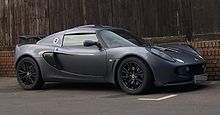
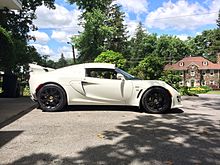
.jpg)
.jpg)
